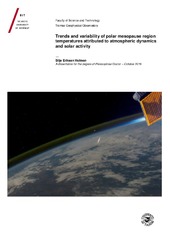Trends and variability of polar mesopause region temperatures attributed to atmospheric dynamics and solar activity
Permanent link
https://hdl.handle.net/10037/10740View/
Thesis (PDF)
Paper 1: Holmen, S. E., Dyrland, M. E., Sigernes, F.: “Mesospheric temperatures derived from three decades of hydroxyl airglow measurements from Longyearbyen, Svalbard (78◦N)”. Also available in Acta Geophysica 2013, 62 (2): 302–315. (PDF)
Paper 2: Holmen, S. E., Dyrland, M. E., Sigernes, F.: “Long-term trends and the effect of solar cycle variations on mesospheric winter temperatures over Longyearbyen, Svalbard (78◦N)”. Also available in Journal of Geophysical Research: Atmospheres 2014, 119:6596–6608. (PDF)
Paper 3: Hall, C. M., Holmen, S. E., Meek, C. E., Manson, A. H., Nozawa, S.: “ Change in turbopause altitude at 52 and 70◦N”. Also available in Atmospheric Chemistry and Physics 2016, 16:2299–2308. (PDF)
Paper 4: Holmen, S. E., Hall, C. M., Tsutsumi, M.: “Neutral atmosphere temperature change at 90 km, 70◦N, 19◦E, 2003–2014”. Also available in Atmospheric Chemistry and Physics 2016, 16: 7853–7866. (PDF)
Date
2016-12-19Type
Doctoral thesisDoktorgradsavhandling
Author
Holmen, Silje EriksenAbstract
The mesopause region can be considered a "boundary region" between the neutral atmosphere, where atmospheric constituents and momentum are transported mainly by winds and turbulent eddies, and the ionosphere, where the main transport mechanism is molecular diffusion. In the mesopause, complex interactions between dynamics and photochemistry occur, and we are far from a complete understanding of these interactions.
This thesis aims to better understand the processes responsible for the large temperature fluctuations we observe in the polar mesopause region, especially the effects of atmospheric circulation and wave activity from lower atmospheric layers. Investigations of trends have also been conducted. To carry out these investigations, we have derived and examined mesopause temperatures from two high-latitude locations: Tromsø (70°N, 19°E) and Longyearbyen (78°N, 16°E), and turbopause height only from Tromsø. A long-term change in turbopause height may be important for understanding processes that are responsible for redistribution of atmospheric constituents.
We examined winter season variations in the hydroxyl (OH*) airglow temperature record from Longyearbyen and identified local temperature maxima in mid-January and mid-February, as well as a minimum in the transition between December and January. We also identified a number of statistically significant periodic oscillations in temperatures derived from the Nippon/Norway Tromsø Meteor Radar, with periods ranging from 9 days to a year. The seasonal variation showed higher temperatures and variability during winter compared to summer. We also found local temperature enhancements just after spring equinox and summer solstice. Temperature variability and seasonal variation may, to a large extent, be explained by the large-scale circulation in the middle atmosphere and corresponding wave activity.
The trends for the Longyearbyen OH* airglow winter temperature series and meteor radar derived temperatures from Tromsø, both annual and summer trends, were estimated to be near-zero or slightly negative. The Tromsø winter trend was negative, (-11.6 ± 4.1) K/decade.
We derived turbopause altitude from turbulent energy dissipation rates obtained from the Tromsø medium-frequency radar and found an increasing height in summer, (1.6 ± 0.3) km/decade, during the time period from 2002 until 2015, while in winter turbopause height did not change significantly. We investigated the response of the change in turbopause height to a change in temperature, but a changing temperature did not alter trends significantly, irrespective of season.
Publisher
UiT Norges arktiske universitetUiT The Arctic University of Norway
Metadata
Show full item recordCollections
Copyright 2016 The Author(s)
The following license file are associated with this item:
Except where otherwise noted, this item's license is described as Attribution-NonCommercial-ShareAlike 3.0 Unported (CC BY-NC-SA 3.0)
Related items
Showing items related by title, author, creator and subject.
-
Scale-free vortex cascade emerging from random forcing in a strongly coupled system
Rypdal, Kristoffer; Ratynskaia, Svetlana; Klumov, Boris; Kozelov, Boris; Knapek, Christina (Working paper; Arbeidsnotat, 2008-03-04)The notions of self-organised criticality (SOC) and turbulence are traditionally considered to be applicable to disjoint classes of phenomena. Nevertheless, scale-free burst statistics is a feature shared by turbulent as well as self-organised critical dynamics. It has also been suggested that another shared feature is universal non-gaussian probability density functions (PDFs) of global fluctuations. ... -
Arctic Entrance: Opening the door to alternative trajectories for Indigenous housing through a decolonizing of planning practice
Stanford, Harriet (Master thesis; Mastergradsoppgave, 2021-06-15)Indigenous communities across Canada are facing a crisis in housing. In response, new and innovative designs, policies, and programs are being developed in attempt to shift away from harmful colonial-imposed models to ones that advance autonomy, healthy living, and cultural revitalization. This important shift has sparked debate and speculation about what a reclaiming or “decolonization” of planning ... -
Statistical analysis of fluctuations in the Alcator C-Mod scrape-off layer
Fritzner, Sindre Markus (Master thesis; Mastergradsoppgave, 2013-06-30)Experimental data from Alcator C-Mod have been used to analyze large density events occurring at the edge of fusion reactors. The data acquisition methods used are gas puff imaging and Langmuir probes. The data consist of long time series sampled at high frequency, excellent for statistical analysis. Large density events have been analyzed where blobs are found to be consistent with high skewness ...


 English
English norsk
norsk



